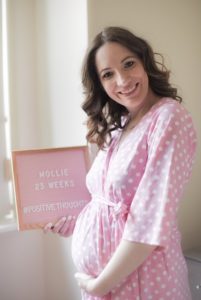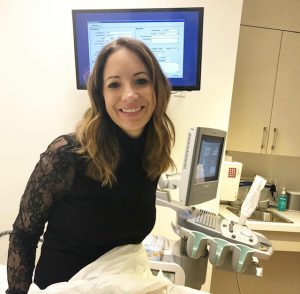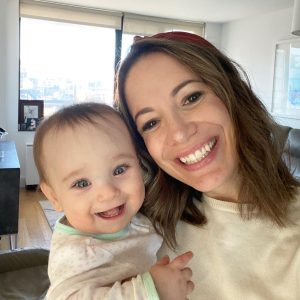By Emily Merrell
We’ve always known that motherhood is a hard job – but the road to motherhood is also something that can be filled with challenges we’d never expect. While Instagram is still filled with pictures of smiling babies, what doesn’t appear are the struggles to create and develop those babies. That’s why I’m grateful for women like Stephanie Cartin who shared the story of her own infertility journey. She opened up about her various fertility cycles and what that looked like, as well as the hardship of losing one of her babies in utero. It’s with great pride and love that I introduce you to Stephanie Cartin and thank her for sharing her journey with us.

SDS: Steph, thank you for being so candid about your fertility journey — at what point did you decide you wanted to share with your following?
STEPHANIE CARTIN: I had met Andrea Syrtash, founder of Pregnantish, through social media when I was going through my infertility journey. When I shared my story with her, she let me know that she felt her community would benefit from hearing what I was going through. I agreed, and in June of 2018 when the piece came out, I went public with what I was going through on instagram. Once I started sharing my journey publicly on social media, it became such a relief. It was as if a weight was lifted off of me. I then started connecting with so many women who were going through similar experiences, some who are now my best friends. I truly believe I was finally able to get and stay pregnant because of the support and encouragement this community so lovingly offered me – in addition to the amazing doctors they connected me with.
SDS: According to the U.S. Department of Health and Human Services, 10 in 100 women struggle with fertility. As an advocate of sharing your journey, what was the response from your community?
SC: The response from my community was so encouraging. I no longer felt alone. More importantly, I was able to connect with and help support so many women by being public about my journey. I had a very complicated fertility journey followed by an even more complicated pregnancy. I’m glad I’ve been able to share what I went through so others who are going through their own struggles don’t feel so alone. There is such strength in this community and together we have been able to help one another immensely. I now get messages daily from women sharing that watching Mollie gives them so much hope. I am glad to pay it back and help as others did for me.
SDS: While many women spend most of their early lives trying not to get pregnant, it’s terrifying to find out how hard it is to actually get pregnant when you want to. Can you share more on your process of choosing IVF and any other treatments you tried before getting pregnant? For our readers unfamiliar with IVF, can you share with us how it works?
SC: I had always said to my husband that my biggest fear in life was not being able to get pregnant. I have wanted to be a mom for as long as I can remember. After my husband and I got married, we decided to do genetic testing before we started trying to get pregnant because of my history of Multiple Sclerosis and other health complications. When the results came back and revealed I was a permutation carrier of fragile X, it was recommended that we see a genetic counselor and then have a consultation with a reproductive endocrinologist. After our first meeting with the RE and learning about the process of going right to IVF in order to do genetic testing on our embryos, we had decided that the odds of our child having a full mutation of fragile X would be so low that we’d prefer to first try to get pregnant on our own and do testing once pregnant. There was no mention at that point about checking my fertility and doing any initial testing to see if I’d even be able to get pregnant.
After about a year of trying to get pregnant unsuccessfully, we decided to go back to the RE. The doctor then saw what he thought was a uterine polyp and sent me for an HSG test. The test confirmed it was a polyp but for some reason, this doctor insisted we still move forward with trying an IUI. Not surprisingly, that first IUI was unsuccessful. This became the first of several red flags with this doctor and I slowly became uncomfortable with the practice and the way it was run. It began to feel more like a factory.
We made the decision to switch to a new doctor and fertility center that was referred by some of the women I had connected with. My new doctor looked at the results of my HSG test and shared there was no point of moving forward with IUI’s until he removed the uterine polyp. I had surgery to remove what we thought would be one polyp and when I woke up from the surgery the doctor shared my entire uterine lining was covered in polyps. Ten to be exact. I was absolutely terrified. Why did I have these polyps and what did this mean?

I now finally had a reason for the mid-month bleeding I had been having for the past 15 years that my gynecologist had continuously brushed off as nothing to worry about. About a week later we got a call from my RE that the results of my biopsy on the polyps had come back and I had an infection called chronic endometritis – inflammation of the uterine lining. My doctor prescribed 10 days of antibiotics and insisted this would take care of the infection. I listened to what he shared without doing additional research and we started the process of doing our next IUI. This was yet another lesson for me.
While it is important to trust your doctor, it is equally important to verify treatment plans they recommend by talking with others who have gone through something similar. Ultimately, our next four IUI’s were unsuccessful. Each month, after my IUI failed, I would ask my doctor if he thought I could still have the infection and this was why I wasn’t getting pregnant. He said no. At the time, I simply believed everything my doctor was telling me because we’re conditioned to assume doctors, as the experienced experts, are always right. Having just begun sharing my journey on Instagram, a few incredible ladies reached out to me and started sharing their similar experiences. We started problem solving together by reading journal articles and learning from our shared experiences. I finally started to feel empowered and realized that I was going to have to play a role in figuring out what was really going on with my body.
At this point we had agreed to move on to the process of IVF, and with my urging, our doctor agreed to do another biopsy during the egg retrieval process to confirm the infection was gone. About a week after my successful egg retrieval, my suspicions were confirmed. My doctor shared that I still had the infection and this was why the IUI’s were not working. I remember being so angry. I went into problem solving mode again and I was determined to figure out the best treatment plan to clear chronic endometritis. After much research and consulting with friends in my community who had gone through this same scenario, I learned that the best treatment to clear the infection would be 3 weeks of 2 specific antibiotics. I shared this with my doctor and he agreed to the plan and prescribed the antibiotics.
This delayed the transfer of our embryo as we first needed to confirm the infection was gone. About a month later we did the repeat biopsy and learned that the antibiotics protocol worked and I no longer had chronic endometritis. However, the biopsy showed that I also had silent endometriosis. Once again, my treatment plan for IVF needed to change and we had to delay the transfer another month so I could start birth control (in order to suppress the endometriosis.) It felt like one road block after another.
At this time I also realized that because of my medical history maybe there was more that was going on in my body. I wanted to be sure that I was tested for other immune issues before we did our transfer, so I was referred to yet another specialist through a friend I made through sharing my story on Instagram. She had helped her sister who had similar issues to me. Through blood tests I found out I also have MTHFR and a few other issues that would require me to be proactive with my treatment leading up to our transfer.
Finally on October 24, 2018 it was the day of our transfer. We put in one embryo. I did everything I could to prepare for this day. I had gone gluten and dairy free to reduce inflammation in my body, I was doing acupuncture once a week and whatever else I could to take care of my body and give myself the best chance of success. I had taken every supplement and medication needed to prepare my body. I knew in my heart this transfer would work. A few days after my transfer I had an urge to take a pregnancy test because I had a feeling in my heart that I was pregnant.
Within seconds a second line appeared. I was pregnant. It was confirmed with a blood test a few days later. Several weeks after that, an ultrasound revealed the embryo had split, and we were now expecting twin girls! Without getting into the full story of our pregnancy here, I can share that we went on to have several more complications, including twin to twin transfusion, the loss of one of our twins and then PPROM. After 17 weeks on bedrest, we welcomed a very healthy baby girl, Mollie Hope, on May 30, 2019. Every single moment of pain and heartache was worth it. Mollie is an amazingly happy baby and I am so blessed to be her mom. If you’re interested in hearing more about our pregnancy journey and how connecting with others helped, you can watch this clip from the Today Show.
SDS: Thanks to your vulnerability sharing your journey. I feel like I learned so much about fertility, tts and what a wild ride fertility really is. Now as a new mom, and reflecting back — what were some of the best resources for women trying to start their family?
SC: Separate from connecting with people who had already been through the same challenges we faced, below are some incredible resources and websites that I recommend when navigating infertility.

My best advice I can share is that there is no such thing as unexplained infertility. You must be your own best advocate and find a doctor that you trust and feel comfortable with who will help you find the answers. If something doesn’t feel right, be sure to trust the voice inside of you. Always hold onto hope. You will get through this and find a way to have your family. Don’t give up and keep searching for the answers. If you ever need an extra boost of hope, feel free to DM me on instagram, I am happy to connect with you!
SDS: In addition to being a new mom, you’re the cofounder of a very cool social media agency called Socialfly. How has motherhood impacted your life as a business owner?
SC: Running a business and being a new mom has been a big adjustment and definitely not easy. Working mamas really are incredible women. Going through infertility and then a very complicated pregnancy was the hardest thing I have ever been through. I know I am stronger now than I have ever been because of what I faced.
I actually feel the ups and downs of owning a business prepared me to face the challenges that I experienced with my fertility and pregnancy journey. I constantly had to problem solve, and every day I was learning something new or dealing with the unexpected. Yet, I still had to stay resilient and positive every step of the way.
Now that we are all living through uncertain times amid COVID-19, I feel like my experience throughout this process prepared me for what we are facing now in the world and in our business. Life can be crazy and unexpected, but I swear there is so much hope and faith no matter what we are facing as long as we surround ourselves with positive and strong people who lift us up.
To hear more of her insight, join Stephanie for a SDS digital event on Tuesday, April 21 at 7:30pmET/4:30pmPT: The Good, The Bad & The Ugly: An Intimate Virtual Conversation About The Infertility Journey. This virtual event will allow you to maintain your privacy while also asking medical professionals and individuals just like you how they managed. The event will kick off with a brief meditation led by Licensed Certified Genetic Counselor and Director of Clinical Genetics, Lauri D. Black. It also features expert insight from Dr. Catenacci from Advanced Fertility, Dr. Li from Pacific Fertility Center and Dr. Fino from NYU. Reserve your spot here.

